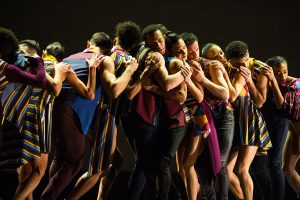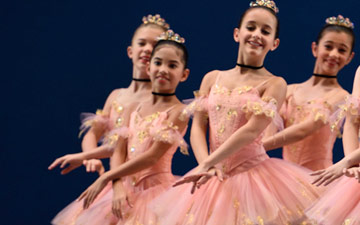
© Laurent Phillipe. (Click image for larger version)
Sankai Juku
Umusuna
San Francisco, Yerba Buena Center for the Arts
9 October 2015
www.sankaijuku.com
www.ybca.org
There was much talk of spiritual awakening as the audience filed out of the YBCA Theater on Friday evening, after the opening performance of Sankai Juku’s Umusuna. Elation is a not-uncommon feeling after seeing the pioneering Japanese Butoh company, whose founder, Ushio Amagatsu, explores the earthly and the infinite through the movement of Butoh and a contemporary sense of theater. In the case of Umusunu, unfortunately, the company’s dramatic presentation drowns out the voice of contemplation.
The visual spectacle of a Sankai Juku performance disarms one’s expectations. Clad in corsets, layered robes and loincloths, their hairless bodies covered in white body chalk that billows off their skin, the all-male, eight-dancer ensemble appears as animated sculpture. During the chorographic process, the dancers themselves develop the sets and effects, which have included color-changing vessels of water, aerial ropes and, for this work, two platforms covered in sand and a stream of sand raining down at upstage center, suggesting the ineluctable passage of time. Pair such conceits with the deliberate, exquisitely interior movement of Butoh, and Sankai Juku can transport the viewer from the here and now to a plane that feels decidedly astral.

© Laurent Phillipe. (Click image for larger version)
Loosely based on the four elements, Umusuna comprises seven sections evoking the erosion of earth, water in the forest, infinite winds and crucibles of fire. Moving surprisingly quickly at times, the dancers segue between the elements in ensembles of three and four, wearing matching costumes and often moving in unison. Masters of their craft, they displayed exquisite precision in lunges that dropped into the sand as well as in the miniscule point of a finger. Silent screams, necks stretched to the sinews, recurred as gestures of rage set to screeching guitar feedback, played at merciless volume. Serene string themes, percussion and sampled nature sounds offered welcome respite from time to time.
And yet for all its sound and fury, Umusuna seemed to signify almost nothing. Neither fully abstract nor committed to a narrative, the work rambles between moments of exquisite beauty. During the forest section, four men stand facing each other across the gap between the sandy platforms, which is lighted in blue like a stream. Each dips his hand into the imaginary water, cups it to his lips and drinks. Ever so slowly, they rise together and curl their arms over the river like willow trees coming into full leaf. Of the work’s many instances of symmetrical unison, it was among the few that didn’t outstay its welcome.

© Laurent Phillipe. (Click image for larger version)
Umusuna’s most abstract, and most captivating, sections were Amagatsu’s solos, dispersed throughout the piece like entr’actes. Now in his mid-sixties, Amagatsu dances within and beyond the limitations of an older body; as is the case with all great artists, he responds to those challenges with more poignant self-expression. In spite of their prodigious gifts, none of the other seven dancers match up to his raw physical presence.
I couldn’t shake the feeling that I’d seen Umusuna before. Online video of Hibiki confirmed it – the guitar feedback, the finger-pointing and the silent screams are all in that much-earlier piece, which benefitted from more diverse movement and dynamic staging. Even Hibiki’s corseted red gowns and drop earrings reappear in Umusunu’s fire sequence.
Haunting themes give artists their point of view. But while Umusuna struck many others as deeply spiritual, its repetitions felt dispiritingly shallow to me. Or perhaps I am just confronting a different void.
Sankai Juku’s North American tour continues through 9 November.

















You must be logged in to post a comment.